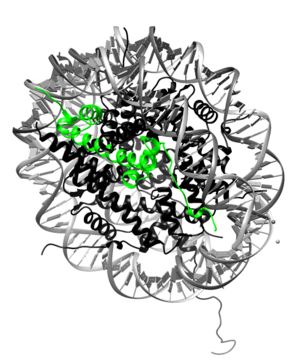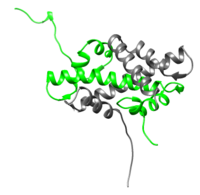User:A. Rahim Zalal/Sandbox 1
From Proteopedia
(Difference between revisions)
(→Histone (H2A)) |
(→Histone (H2A)) |
||
| Line 2: | Line 2: | ||
[[Image:H2A.png|300px|right|thumb| H2A highlighted (green) in nucleosome. The complexed DNA is gray, and the rest of the core proteins are black. [[1aoi]]]] | [[Image:H2A.png|300px|right|thumb| H2A highlighted (green) in nucleosome. The complexed DNA is gray, and the rest of the core proteins are black. [[1aoi]]]] | ||
| - | The histone family's H2A protein family act as a subunits of eukaryotic nucleosomes. Specifically, H2A molecules form dimers with H2B molecules that interact with tetramers of histones H3 and H4 to form the octameric histone core of the nucleosome. All of the core histone proteins also interact with DNA in ways that allow for DNA compaction. | + | The histone family's H2A protein family act as a subunits of eukaryotic nucleosomes. Specifically, H2A molecules form dimers with H2B molecules that interact with tetramers of histones H3 and H4 to form the octameric histone core of the nucleosome. All of the core histone proteins, including H2A, also interact with DNA in ways that allow for DNA compaction. |
__TOC__ | __TOC__ | ||
Revision as of 18:36, 2 May 2014
Histone (H2A)

H2A highlighted (green) in nucleosome. The complexed DNA is gray, and the rest of the core proteins are black. 1aoi
The histone family's H2A protein family act as a subunits of eukaryotic nucleosomes. Specifically, H2A molecules form dimers with H2B molecules that interact with tetramers of histones H3 and H4 to form the octameric histone core of the nucleosome. All of the core histone proteins, including H2A, also interact with DNA in ways that allow for DNA compaction.
Contents |
Structure

H2A:H2B dimer (H2A is represented in green while H2B is represented in gray), 1aoi
Function
Sequence
Protein Primary Sequence
The sequence for histone H2A type 1 (human) is presented here[1]:
10 20 30 40 50 60
MSGRGKQGGK ARAKAKTRSS RAGLQFPVGR VHRLLRKGNY AERVGAGAPV YLAAVLEYLT
70 80 90 100 110 120
AEILELAGNA ARDNKKTRII PRHLQLAIRN DEELNKLLGK VTIAQGGVLP NIQAVLLPKK
130
TESHHKAKGK
Coding DNA Sequence
The coding DNA sequence for the H2A type 1 subunit (human)[2]:
ENA|AAA63191|AAA63191.1 Homo sapiens (human) histone H2A.1 : Location:1..393 ATGTCTGGACGTGGAAAGCAAGGCGGCAAAGCTCGGGCAAAAGCTAAAACGCGTTCTTCC AGGGCCGGTCTTCAGTTTCCAGTTGGCCGTGTGCACCGCCTCCTCCGCAAAGGCAACTAC TCCGAACGAGTCGGGGCCGGCGCTCCAGTGTACCTGGCAGCGGTGCTGGAATATCTGACG GCCGAGATCTTAGAGCTAGCTGGCAACGCGGCTCGCGACAATAAGAAGACCCGCATCATC CCGCGCCACCTGCAGCTAGCCATCCGCAACGACGAGGAGCTAAATAAGCTTCTAGGTCGC GTGACCATCGCGCAGGGCGGTGTCCTGCCCAACATCCAGGCCGTATTGCTGCCTAAGAAG ACGGAGAGCCACCATAAGGCCAAGGGCAAGTGA
Mechanism
This is a sample scene created with SAT to by Group, and another to make of the protein. You can make your own scenes on SAT starting from scratch or loading and editing one of these sample scenes.
References
- ↑ Marzluff WF, Gongidi P, Woods KR, Jin J, Maltais LJ. The human and mouse replication-dependent histone genes. Genomics. 2002 Nov;80(5):487-98. PMID:12408966
- ↑ Albig W, Kardalinou E, Drabent B, Zimmer A, Doenecke D. Isolation and characterization of two human H1 histone genes within clusters of core histone genes. Genomics. 1991 Aug;10(4):940-8. PMID:1916825
